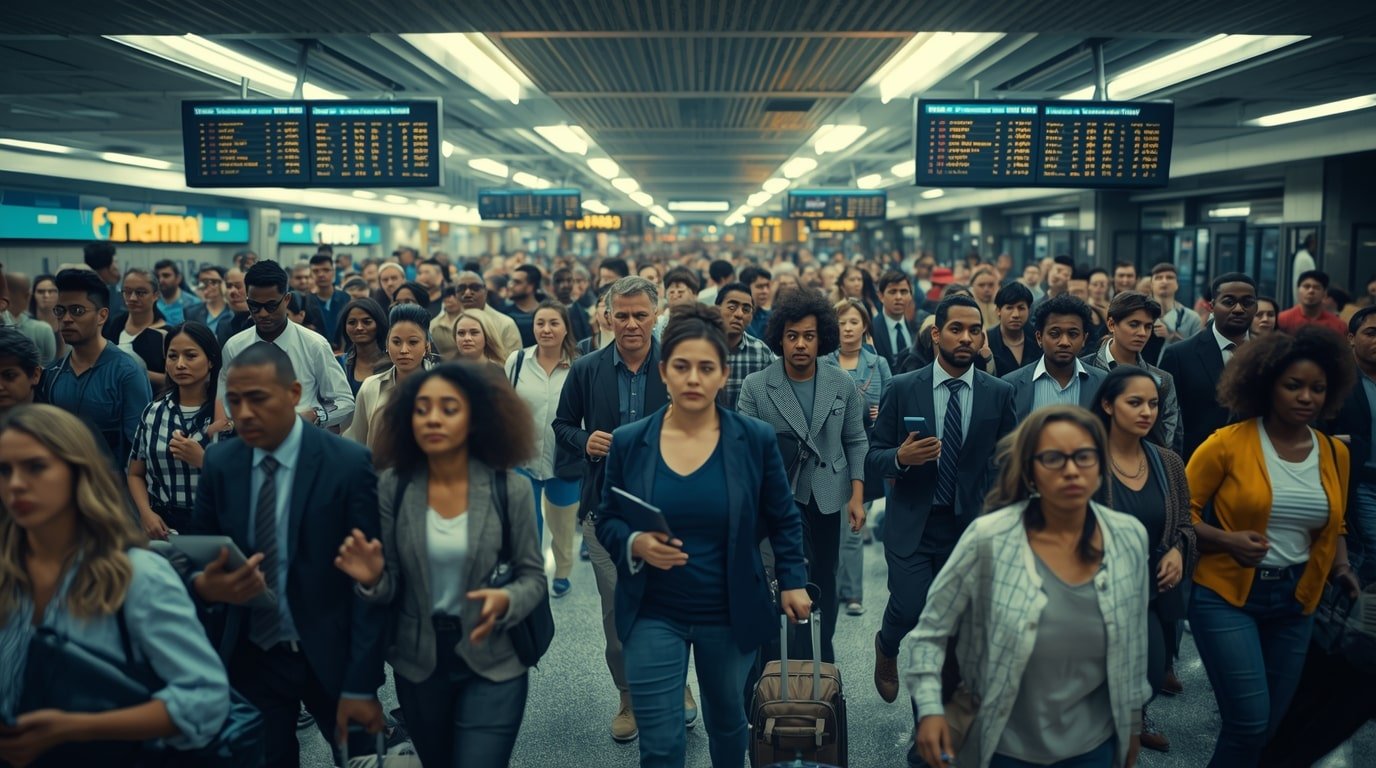Trump’s H-1B Visa Fee Shock Rocks Global Tech Sector as Deadline Looms Today

And, in a decision that has shocked Silicon Valley and elsewhere, the U.S. President Donald Trump signed an executive order on Friday that has caused a shocking increase in fees on new visa applications under the H-1B program to a head-shattering 100,000 dollars, which will come into effect at the stroke of Midnight of September 21, 2025.
The policy, to reduce what the administration terms as abusive immigration habits by the technological companies, has seen panic scrambles by multinational corporations to take home thousands of foreign employees before the deadline. With the clock slowly running out, industry leaders are afraid of possible disruptions in projects, a shortage of talent and a chilling impact on the innovation base of America in the global technological competition.
The document is known as the Restriction on Entry of Certain Nonimmigrant Workers and is aimed at high-skilled visas that are vital to software engineers, data scientists, and AI experts in such countries as India and China. Trump justified the fee as a required disincentive to companies that pay foreigners less than American employees, citing the number of H-1B slots approved by IT giants in fiscal year 2025 (more than 85,000).
It is criticised, however, as a political act of sabotage of the sector that has allowed him to be re-elected with record contributions. By noon Sunday, emails went out to Amazon, Microsoft, and JPMorgan Chase asking workers working in countries outside the US to board the following flight.
H-1B Revamp Causes Corporate Panic and Diplomatic Rifts
It started nearly immediately after the White House announcement on September 19. Hours later, an internal memo of Amazon was leaked to reporters, stating an emergency to its estimated 20,000 H-1B holders, most of whom are based in Seattle and Austin hubs.
The message said that “Efficient 12:01 a.m. EDT September 21, all nonimmigrant petitions will be restricted and charged new entry fees due to the existing policies to encourage staff to ensure that all nonimmigrant petitions are returned immediately to prevent denial of re-entry that would render all important cloud computing and e-commerce projects inoperative.
Microsoft, in turn, also acted in line with this, as CEO Satya Nadella took part in a video call with teams himself, highlighting that the company intends to invest in diverse talent pipelines, but is scrambling to get workers in India and Europe to work.
JPMorgan, which is slightly less of a tech but highly dependent on fintech talent, had a much shorter deadline with a threat of disrupting the payrolls of its 5,000-plus visa-dependent quants and developers. The bank’s instruction emphasised the per-petition nature of the fee, i.e., renewals and extensions could result in costs of millions of dollars per year for large employers. In Europe, tech hubs such as Google’s Dublin campus were creating the same level of chaos, with flights between Shannon Airport and San Francisco completely booked until Tuesday.
India, which hosts 71 per cent of H-1B recipients, is the most acute recipient of the policy. A very sharp warning came on early Sunday by the National Association of Software and Service Companies (NASSCOM), which represents more than 2,800 companies in the industry: This sudden $100,000 tax will derail some of the ongoing U.S. projects that have a total worth of billions of dollars, and it will necessitate a rethink of offshore strategies.
Some stock declines in companies such as Infosys and TCS in the Bengaluru IT corridor, which was already looking shaky due to previous trade frictions, caused a further setback to the companies as the executives held urgent board meetings.
An anonymous independent Tata Consultancy Services manager replied to journalists, “We already have teams half-deployed on AI-based banking apps – a 10 per cent loss of our U.S.-bound engineers may cascade into quarters-long delays.
White House officials went into rapid moves to clarify the grey areas that were causing the panic. Press Secretary Karine Jean-Pierre declared in Sunday morning briefing that the fee would only apply to those who were new applicants, but not retroactively to those who had an existing visa or routine extensions.
It was not about chaos but about fairness, she made it clear and raised her finger to a 12-month sunset clause between September 21, 2025, and September 20, 2026, subject to potentially being extended depending on data on the labour market.
But the damage to credibility had been wrought; the foreign governments, such as that of India, the Ministry of External Affairs, had also protested on record, denouncing the step as discriminatory and disruptive to the economy.
The tech lobby groups, such as the Information Technology Industry Council (ITI), came out with a protest with their CEO, Dean Garfield, terming the order as a self-inflicted wound on the competitiveness of the U.S. Garfield observed in an op-ed to Capitol Hill that H-1B workers add to the economy at a rate of $200 billion a year.
They fill gaps in STEM sectors where the shortfall in the United States remains an issue. The situation is ironic: the base of his supporters in Rust Belt states is chanting about America First, but now Silicon Valley funders who funded his campaign are confronted with a talent leak to the cheaper countries of Toronto or Hyderabad.
xAI’s $10 Billion Windfall Signals AI Arms Race Acceleration
Announced during the visa crisis, the xAI of Elon Musk made the headlines as the company announced a blockbuster 10 billion funding round, valuing it at more than 200 billion, the largest valuation of any AI start-up to date.
The infusion, which is spearheaded by venture heavyweights Sequoia Capital and Andreessen Horowitz, closes on September 21 and reflects the unquenchable investor interest in generative AI due to geopolitical headwinds.
As usual, provocateur Musk tweeted as he was flying his personal jet to a data centre groundbreaking in Memphis: xAI is not merely raising money–we are Arming the Future. Grok 4 is released tomorrow, and it is the fastest yet and cheapest.
The capital will drive the growth of the Colossus supercomputer system of xAI in Tennessee, which already has 100,000 Nvidia H100 GPUs, indicating that its capacity will reach 200,000 by the end of the year.
Analysts estimate the terms of the round to be 25% higher than the April 2025 valuation of $160 billion of xAI, which represents bets about its lead in multimodal AI models combining text and vision with real-time decision-making.
The increment comes at a critical point. As the latest GPT-5 release by OpenAI has been held by a safety audit, the Grok series of xAI, which was launched with a provocative marketing slogan of maximum truth-seeking, has garnered 15% market share in enterprise deployments.
First movers such as Tesla’s autonomous driving unit and SpaceX’s mission control are adopting Grok 4 Fast, citing 98% cost inference reduction on benchmarks, which makes real-time satellite trajectory optimisations feasible. However, this raises some concerns about the sustainability: Musk has a track record of overpromising on schedules, and xAI has obscure governance, which is of concern to institutional investors who might face regulatory oversight.
The news spreads worldwide into the Asian AI centres. In Singapore, Temasek Holdings, a major investor, celebrated the deal, saying it was a bridge across the Pacific to joint innovation, and Beijing state media packaged it as a sign of U.S. desperation to offset Ascend chips by Huawei.
The AI Act of Europe, which is still new to enforcement, is looking at the growth of xAI with a look of suspicion, and Brussels is insisting that information that underpins it is disclosed to prevent antitrust investigations.
TikTok Strikes US-China Accord, Averting ByteDance Ban
In a diplomatic push and pull, the White House announced a new model of TikTok that would enable American control of its board and core algorithm, potentially obstructing a national ban. The specifics, which were worked out after a marathon of negotiations between U.S. Treasury representatives and the head of ByteDance in Washington, were announced on Sunday afternoon, with October 1 set as the implementation date.
A U.S.-majority board is going to be in charge of content control and algorithmic adjustments under the agreement, which will be responding to national security apprehension that Beijing might have over its impact.
The code, which contains confidential algorithms that drive feeds for 1.7 billion users, will be audited quarterly by external companies such as Deloitte, ensuring that there is no backdoor access by Chinese intelligence services. In turn, ByteDance maintains operational control in markets outside the U.S., a compromise that preserves its worldwide valuation of $ 220 billion.
Egen Z creators and e-commerce hustlers were relieved to see TikTok had 170 million American users. In a live stream event located in New York, CEO Shou Zi Chew referred to it as a win in open innovation and made a commitment to invest in U.S. data centres to the tune of 2 billion dollars within the next five years.
Critics such as the Senate Commerce Committee chair, Maria Cantwell, are still not convinced, promising to hold hearings on oversight to investigate the enforcement teeth. To China, the agreement would be a departure from tech nationalism and potentially open the possibility of lessened regulations on U.S. companies, such as Apple, within the retaliation-threatening industries.
Greater Implications: AR Wearables to Green Energy Leaps
Outside the headlines, September 21 was full of marginal improvements that were defining the future of technology. Meta also released prototypes of its AR glasses, the Orion, at a demo in Palo Alto, and the glasses dropped the heavy headsets in favour of lightweight frames to overlay holographic interfaces on reality.
The device has a custom Qualcomm Snapdragon XR3 as the chip to ensure it integrates well with WhatsApp and Instagram, with an intended consumer launch in 2027. Even pretest participants were exuberant with gesture controls on virtual meetings, but privacy lobbyists raised the always-on cameras as a surveillance Trojan horse.
The offshore wind turbine had a breakthrough in its efficiency, reported by one of the leading consortia led by Siemens Gamesa, which increased the output by 25% through AI-optimised blade designs. A grid off the coast of Denmark would supply power to 500,000 households by 2026, aligning with the UN’s net-zero targets as it prepares for COP30.
On the same note, Nvidia had its Blackwell Ultra, promising 10x faster AI training on edge devices, which is beneficial to autonomous drones in war-torn countries such as Ukraine, according to a virtual keynote. The dichotomy was seen in stock markets where Nasdaq futures fell 1.2% on visa jitters, falling Infosys 4% and Cognizant 3% and xAI-related plays such as Nvidia rose 2.8%.
During dusk on September 21, the technology community is holding its breath. Will the H-1B fee change the world’s talent distribution, or will it spark a talent education renaissance in the United States? There is one thing that is certain in the fractured alliances: the fault lines of innovation have never been as deep as they are now.


